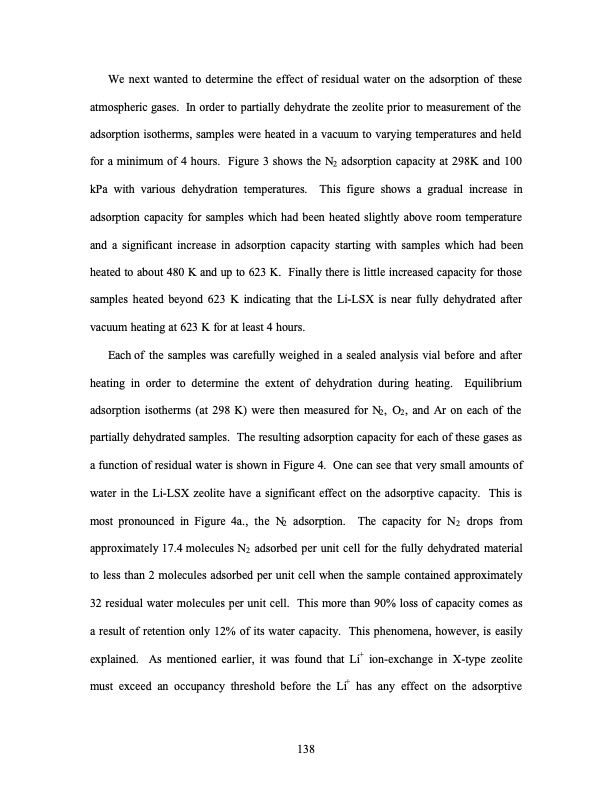
PDF Publication Title:
Text from PDF Page: 138
We next wanted to determine the effect of residual water on the adsorption of these atmospheric gases. In order to partially dehydrate the zeolite prior to measurement of the adsorption isotherms, samples were heated in a vacuum to varying temperatures and held for a minimum of 4 hours. Figure 3 shows the N2 adsorption capacity at 298K and 100 kPa with various dehydration temperatures. This figure shows a gradual increase in adsorption capacity for samples which had been heated slightly above room temperature and a significant increase in adsorption capacity starting with samples which had been heated to about 480 K and up to 623 K. Finally there is little increased capacity for those samples heated beyond 623 K indicating that the Li-LSX is near fully dehydrated after vacuum heating at 623 K for at least 4 hours. Each of the samples was carefully weighed in a sealed analysis vial before and after heating in order to determine the extent of dehydration during heating. Equilibrium adsorption isotherms (at 298 K) were then measured for N2, O2, and Ar on each of the partially dehydrated samples. The resulting adsorption capacity for each of these gases as a function of residual water is shown in Figure 4. One can see that very small amounts of water in the Li-LSX zeolite have a significant effect on the adsorptive capacity. This is most pronounced in Figure 4a., the N2 adsorption. The capacity for N2 drops from approximately 17.4 molecules N2 adsorbed per unit cell for the fully dehydrated material to less than 2 molecules adsorbed per unit cell when the sample contained approximately 32 residual water molecules per unit cell. This more than 90% loss of capacity comes as a result of retention only 12% of its water capacity. This phenomena, however, is easily explained. As mentioned earlier, it was found that Li+ ion-exchange in X-type zeolite must exceed an occupancy threshold before the Li+ has any effect on the adsorptive 138PDF Image | PSA USING SUPERIOR ADSORBENTS

PDF Search Title:
PSA USING SUPERIOR ADSORBENTSOriginal File Name Searched:
789503.pdfDIY PDF Search: Google It | Yahoo | Bing
CO2 Organic Rankine Cycle Experimenter Platform The supercritical CO2 phase change system is both a heat pump and organic rankine cycle which can be used for those purposes and as a supercritical extractor for advanced subcritical and supercritical extraction technology. Uses include producing nanoparticles, precious metal CO2 extraction, lithium battery recycling, and other applications... More Info
Heat Pumps CO2 ORC Heat Pump System Platform More Info
| CONTACT TEL: 608-238-6001 Email: greg@infinityturbine.com | RSS | AMP |